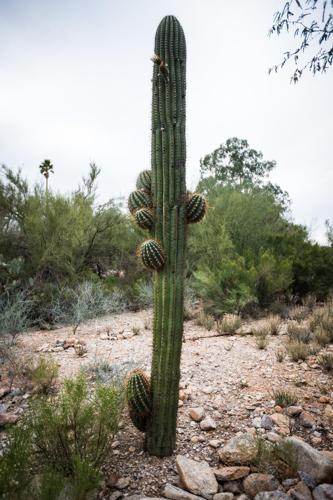Q: We live on a property in the near foothills on the east side of town that has a number of saguaros. There is one cactus that we’d always assumed was just an odd looking saguaro because it is about the same size as many of the saguaros in our yard. This morning, we noticed that it has two blooms and they are quite different from those on saguaros. We also realized that while the spines are similar to those on a saguaro, they differ too. Can you help us identify this cactus?
A: From your photo this appears to be an Argentine saguaro (Echinopsis terscheckii), aka cordon grande. This species is sometimes planted in our area for its ability to withstand cold weather. It grows faster than the native saguaro and is hardier so it can be grown in slightly colder climates. As you noticed, the flowers look more like a cereus than a saguaro and the spines are longer as well.
Q: I think it’s nearly time to begin pruning my grapevines (two Red Flame and one Thompson green) and seems like it’s a good idea to address last year’s pests. Although the photo shows the arbor in shade, the vines get six to eight hours of sun daily. In the summer, the drip system provides each vine with one gallon per hour, four days a week, for an hour and a half. And last summer, boy did we have bugs. I use Bt for one kind of caterpillar that has been with us since the beginning, coming up on four years, but it didn’t seem to faze them. I’d prefer a systemic, because our monsoons wash sprays off. I’m happy to forgo harvesting grapes for another year or two. What is your recommendation?
A: Bt (Bacillus thuringiensis) is helpful in managing caterpillars such as the grape leaf skeletonizer (Harrisina brillians). Bt doesn’t have any affect on the various species of leafhoppers that are causing the damage in the photo. Leafhoppers suck the sap from leaf cells causing the yellow appearance you are seeing. Grape plants can withstand a good amount of feeding damage before fruit yield is affected so you might not have to do anything. There are also natural enemies that feed on the leafhoppers so you probably already have some help managing them. If you want to determine if treatment is recommended, you can monitor the population by counting the number of leafhoppers per leaf on a random sample of leaves. If the number per leaf exceeds 15, then it might be worth treating. There are systemic insecticides available for this purpose and they can be applied as a soil drench. Active ingredients for these chemicals are toxic to bees and other animals so please follow label instructions if you go this route. So my recommendation is to assess the situation before treating because you might save money by monitoring them this spring.
Question: I have a Mexican palm that is about 25 feet high and still growing. Is there any way to slow it down or stop it from growing? Also it is 6 feet from an in-ground pool and 2 feet from brick wall. Should I be concerned about this?
Answer: Palm trees, like other tree species, tend to slow down growth when they receive less water. You can’t stop it from growing unless you use a chainsaw. Trees growing too close to structures can be a problem as their roots grow and seek water. I think your description warrants a visit from a certified arborist to determine the gravity of your situation. Palm trees are not as big a problem as some other trees that have larger root systems but they can still disrupt hard structures over time.
Question: I have a mature grapefruit tree I have been maintaining for three years ago. I keep it watered, fertilized and trimmed. It has always given me many wonderful juicy pink grapefruit, which I love, and share with friends. This spring, I noticed very few blossoms and now there are very few (probably less than 50 total) grapefruit on the tree. The existing fruit has extremely thick rinds, about 1ƒ inches thick, leaving very little room for the inside fruit. Did I do something wrong to have this problem? I love this tree and the fruit and would appreciate any help you can give me to do whatever it takes to bring back the bounty come next spring.
Answer: I recommend you double-check the fertilizer amount, timing, and type you are supplying. Over time, trees with an imbalance of nutrients may develop thick rinds. Nitrogen is often the main ingredient in fertilizer but trees also need a small amount of phosphorus and potassium. There are some fertilizers designed and sold for citrus. If you aren’t already using one of these, it might be worth switching. You also might also double-check the watering schedule to make sure that is correct. It should be every 14 to 21 days to a depth of 36 inches in the winter, every 10 to 14 days in the spring and fall, and every seven to 10 days in the summer. Trimming your citrus tree is not something recommended unless there are dead or damaged branches.





